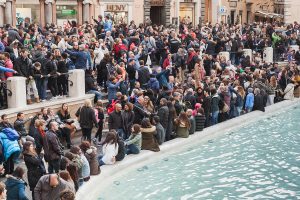
Italy has seen a steady rise in tourism over the past years, and while good for its economy, the number of visitors that descend upon the country’s most-visited areas each year definitely takes a toll on resources. In 2014, Italy was the fifth most-visited country in the world, with 48.6 million tourists; that number has been rising since, with 2016 on track to see a record number of visitors to the country.
This summer, tourism is estimated to be up 5% in Venice, 5.6% in Florence, 9% in Capri and 20% in Cinque Terre from 2015. One possibility for the increase in visitors is that people, including Italians, feel safer vacationing in Italy than in nearby countries such as Turkey or France that have been targets of terrorist attacks.
Authorities are worried that overcrowding at the country’s most popular tourist spots, including Rome, Venice, Florence, Cinque Terre and Capri, will lead to deterioration and pollution of Italy’s natural environment and damage to its precious historical sites. Especially concerning to some is the large number of day visitors to places like Venice, Capri and Cinque Terre; these visitors often come from cruise ships, trains, or ferries and don’t contribute to the local economy by staying overnight, but still have the same impact on the environment.
“In Capri, we have exceeded our limits for sustainable tourist flows, we live among the problems of congestion which are doing irreparable damage to our reputation,” Gianni De Martini, the mayor of Capri told La Stampa.
De Martini has considered reducing the number of ferries to one every 20 minutes, as well as the number of cars allowed on the island.
Local authorities, including Venice Mayor Luigi Brugnaro, are putting together a plan to reduce the impact of tourists on their cities, and plan to submit it to the national government. Brugnaro who took office in June 2015, gave Venetians priority boarding access to some of the city’s vaporetti this year by creating separate tourist queues and enabling locals to board first. He believes the 25 million tourists who come to his city — a significantly higher number than the city’s total population of 264,579 — “[risk] flaring confrontation between tourists and residents.”
Earlier this year, a proposal by the five cities that comprise Cinque Terre National Park to restrict the number of visitors to the area caused controversy between locals and foreigners. However, insiders say the government is unlikely to approve that proposal, which would have cut the number of tourists from 2.5 million per year to 1.5 million by selling a limited number of entrance tickets to the park.
“We are working on a plan that will find ways to resolve the issue of overcrowded places,” Fabio Lazzerini, a director of Enit, the Italian tourism board, told The Local. “Some places have been thinking of limiting tourist access, in addition to taxes for entering town centres. The debate is still ongoing.”
But rather than limiting the number of visitors allowed in to Italy’s most beloved cities, which would be logistically difficult to enforce, some local officials hope to promote less-traveled areas in the country, particularly targeting repeat visitors who have already seen the major attractions. Another strategy would be to alert visitors who are booking trips online that popular sites may be unbearably crowded during peak season and that visitors may find their experience unpleasant if services such as transport, restaurants and hotels are overloaded.
“We have to work to raise the level of tourism in Italy – we need to attract visitors to other, less well-known destinations,” said Lazzerini. “ENIT and the Ministry of Culture are working together to create a demand for other places. We also need to raise the profile of sites within major cities – for example, in Rome, most people will go to the Colosseum or Trevi Fountain, without knowing that there are plenty of other places worth seeing.”
By Kathy McCabe
Want to read more about travel? Get your free copy of our new digital magazine, Perillo Traveler!

Actually, Italy is the 4th most visited country in the world. China inflates its tourist stats, only 20 million foreigners visited China in 2015: https://www.travelchinaguide.com/tourism/2015statistics/inbound.htm 80% of China’s “foreign” tourists come from Hong Kong, which should be counted as domestic tourists. HK doesn’t count mainland Chinese tourists as foreign tourists.